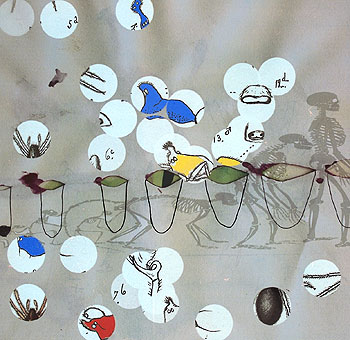Art and medicine have changed drastically since the early 16th century, when the Veronese anatomist Marcantonio della Torre famously conducted dissections with Leonardo Da Vinci. Yet numerous commonalities remain — the appreciation of complexity; the importance of careful observation; the intrinsic understanding of human frailty.
Such themes inform the work of Carmon Colangelo, dean of the Sam Fox School of Design & Visual Arts and the E. Desmond Lee Professor for Collaboration in the Arts. Over the last several years, Colangelo — known for creating large-scale multimedia prints — has developed an extensive body of work investigating the moral and ethical questions raised by contemporary research into human genetics.

“This is one of the most important issues of our era, and I think we’re at something of crossroads in terms of the politics and our ability to move forward,” Colangelo said. “I wanted to explore the conversations and controversies surrounding bioengineering and cloning, as well as the popular mythologies about them — the horror stories of science gone wrong. These stories, right or wrong, are shaping public attitudes toward scientific research, medicine and religion.”
This fall, the School of Medicine will present “Carmon Colangelo: Prints” in Farrell Learning and Teaching Center, 520 S. Euclid Ave.
The exhibition will open with an artist’s talk at 7 p.m. Friday, Sept. 14. A reception immediately follows. The exhibition is free and open to the public and remains on view through January 2008. The Farrell Center is open from 9 a.m. to 5 p.m. Monday through Friday.
Curated by Bruno David, who handles Colangelo’s work for the Bruno David Gallery, the exhibition will showcase more than a dozen prints inspired by medical and scientific issues.
“Through his provocative work, Carmon presents an artist’s vision of the many dimensions of biomedical research,” said Larry J. Shapiro, M.D., executive vice chancellor for medical affairs and dean of the School of Medicine. “Carmon’s artistic explorations will give our students, faculty and staff much to ponder and discuss along the way to the clinics, the lab and the classrooms.”
Colangelo was deeply influenced by “Body Bazaar: The Market for Human Tissue in the Biotechnology Age” (2001) by Lori Andrews and Dorothy Nelkin. The book documents the ways various commercial interests have come to regard human cells and DNA as natural resources that can be harvested and even patented, sometimes without the knowledge or consent of the health care consumer.
Conversely, Colangelo also was struck by the continuing tensions between the scientific and religious communities on issues ranging from evolution to stem cell research.
Still, in his own work, Colangelo tries to avoid editorializing.
“It’s not really about taking a particular stance or deciding what is right or wrong,” he said. “It’s about capturing the feeling and sensibility of the issues without actually telling a story. I want the work to have a kind of strangeness that you can’t quite pin down.
“I started with the idea of creating very simple drawings and taxonomies of anatomical parts,” Colangelo said. “I did a series about spiders and then moved on to ‘Gray’s Anatomy,’ scanning things into the computer and mixing them up, taking them apart and distorting them to get different qualities.”
“Evolution” and “Devolution,” for example, is a large diptych based on a familiar natural history graphic. In “Evolution,” a line of subtly printed skeletons advances from small creatures to larger, four-legged mammals and eventually to primates and humans. A row of rough conical shapes, possibly suggesting test tubes, is overlaid, while scattered about the image are small spheres containing anatomical details of spiders. In “Devolution,” the entire scene is reproduced again, this time juxtaposed with thin horizontal bands recalling corrupted digital images.
“They’re derived from the lessons of the spider drawings and use cut-outs, both in the paper and digital, to construct and deconstruct the image and meaning,” Colangelo said. “A blue translucent overprinting gives the feeling of a TV or computer screen space.”
“Bride and Groom” depicts a skeletal couple draped in thick red lines that suggest a sort of crude circulatory system. Flanked by a colorful confetti that might be pills or strands of DNA, the figures are joined at the neck by the outline of a large hand while a bright, gown-like cascade of white — topped by the head of a cartoon buzzard — spills between them. A neon green bunny floats upside down above the scene.
“It’s a real strange configuration of things,” Colangelo said, “everything from fuzzy animals to bone structures, blood cells and dissections of the body.
“I see them as a little comical, a playful language-of-images that creates a kind of visual tension around these subjects and their paradoxes.”
For more information on the exhibit, call 747-3284 or visit fltc.wustl.edu.
In addition, Colangelo’s most recent series, “Pharmland,” is on view through mid-October at the Bruno David Gallery, 3721 Washington Blvd. Hours are 10 a.m. to 5 p.m. Wednesday through Saturday. The gallery is free to the public. For more information, call 531-3030 or visit brunodavidgallery.com.